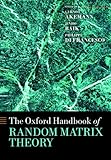The Oxford handbook of random matrix theory
Material type: TextPublication details: New York: Oxford University Press, [c2015]Description: 919 pISBN: 9780198744191LOC classification: QA188Summary: This handbook showcases the major aspects and modern applications of random matrix theory (RMT). It examines the mathematical properties and applications of random matrices and some of the reasons why RMT has been very successful and continues to enjoy great interest among physicists, mathematicians and other scientists. It also discusses methods of solving RMT, basic properties and fundamental objects in RMT, and different models and symmetry classes in RMT. Topics include the use of classical orthogonal polynomials (OP) and skew-OP to solve exactly RMT ensembles with unitary, and orthogonal or symplectic invariance respectively, all at finite matrix size; the supersymmetric and replica methods; determinantal point processes; Painlevé transcendents; the fundamental property of RMT known as universality; RNA folding; two-dimensional quantum gravity; string theory; and the mathematical concept of free random variables. In addition to applications to mathematics and physics, the book considers broader applications to other sciences, including economics, engineering, biology, and complex networks.--- summary provided by publisher
TextPublication details: New York: Oxford University Press, [c2015]Description: 919 pISBN: 9780198744191LOC classification: QA188Summary: This handbook showcases the major aspects and modern applications of random matrix theory (RMT). It examines the mathematical properties and applications of random matrices and some of the reasons why RMT has been very successful and continues to enjoy great interest among physicists, mathematicians and other scientists. It also discusses methods of solving RMT, basic properties and fundamental objects in RMT, and different models and symmetry classes in RMT. Topics include the use of classical orthogonal polynomials (OP) and skew-OP to solve exactly RMT ensembles with unitary, and orthogonal or symplectic invariance respectively, all at finite matrix size; the supersymmetric and replica methods; determinantal point processes; Painlevé transcendents; the fundamental property of RMT known as universality; RNA folding; two-dimensional quantum gravity; string theory; and the mathematical concept of free random variables. In addition to applications to mathematics and physics, the book considers broader applications to other sciences, including economics, engineering, biology, and complex networks.--- summary provided by publisher
| Item type | Current library | Collection | Shelving location | Call number | Status | Notes | Date due | Barcode | Item holds |
|---|---|---|---|---|---|---|---|---|---|
 Book
Book
|
ICTS | Mathematic | Rack No 4 | QA188 (Browse shelf (Opens below)) | Available | Invoice no. IN 469 ; Date 04-07-2019 | 02134 |
This handbook showcases the major aspects and modern applications of random matrix theory (RMT). It examines the mathematical properties and applications of random matrices and some of the reasons why RMT has been very successful and continues to enjoy great interest among physicists, mathematicians and other scientists. It also discusses methods of solving RMT, basic properties and fundamental objects in RMT, and different models and symmetry classes in RMT. Topics include the use of classical orthogonal polynomials (OP) and skew-OP to solve exactly RMT ensembles with unitary, and orthogonal or symplectic invariance respectively, all at finite matrix size; the supersymmetric and replica methods; determinantal point processes; Painlevé transcendents; the fundamental property of RMT known as universality; RNA folding; two-dimensional quantum gravity; string theory; and the mathematical concept of free random variables. In addition to applications to mathematics and physics, the book considers broader applications to other sciences, including economics, engineering, biology, and complex networks.--- summary provided by publisher


There are no comments on this title.